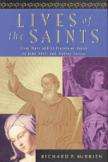Ordinary and Extraordinary
The Rev. Richard P. McBrien, the Crowley-O’Brien Professor of Theology at the University of Notre Dame (Lives of the Saints, Catholicism), in this one-volume treatment provides, in portable and more affordable form, the quality otherwise found only in the 12-volume, 1995 Burns edition of Butler’s Lives of the Saints. This was no easy task.
The notion of saint has two components, internal and external. The internal element is the actual condition of sanctity, or holiness, an individual’s likeness to and union with the God who is love. The external dimension is the judgment, by religious authority formally, or the community informally, that the condition of sanctity does, in fact, exist in a given person, and that this person is worthy of honor from, and imitation by, the members of the community.
To complicate matters, the internal condition and the external judgment shape each other over time, changing reciprocally. Both respond (if somewhat differently, even contradictorily), to pressures from the world outside religion and to stresses and factions within the religious community itself. Everything in this multidimensional dynamic is in motion, even the underpinning religious assumptions and especially the understanding of God.
The chief problem McBrien has solved in writing Lives of the Saints is to make a single, unified work of what could easily have split into two books, a collection of lives and a treatise on sanctity and saint-making. He has found a place to stand and a way to express in language (essentially linear) these ongoing, simultaneous realities. His style walks the elusive ground between the scholarly and the popular, and his solution is both successful and elegant.
With the content of the collection, McBrien attempts some (necessarily silent) bridge-building in several directions. Pre- and post-Vatican II sensibilities are addressed by noting, in the traditional vita format, current concerns and modern theological attitudes and practices, where these occur. Lives drawn from the calendars of religious orders, and from Greek and Russian Orthodox, Anglican and Lutheran calendars, supplement the General Roman Calendar, which provides the basis and bulk of the collection.
And so, without saying a word, the collection can both show the common grounds of belief and religious experience among us (a prerequisite for any movement toward the reunification of Christianity) and suggest directions for theological conversation and Christian response that we might all profitably pursue.
Finally, the inclusion of 32 historically significant holy persons who have not yet been recognized officially by the Catholic Church as worthy of public veneration indicates directions church concerns and attitudes have been taking since the Second Vatican Council.
That is not to say that all of McBrien’s entries will be greeted with equal delight. The omission of Opus Dei’s founder, Blessed Josemaría Escrivá de Balaguer, from the lives, despite the vivid and frank description of his beatification process, will certainly not pass unremarked.
Some eyebrows will doubtless be raised at the appearance among the unofficial holy people of Mohandas Gandhi, George Fox, Cesar Chavez and Dorothy Day, though probably Mother Teresa of Calcutta and James E. Walsh will surprise only by their lack of church recognition. McBrien’s choices among the holy people formally recognized by the Lutheran and Anglican churches, among them Martin Luther, Martin Luther King Jr., Jonathan Edwards, Chief Noah Seattle, the Roman Catholic Archbishop Oscar Romero, John Calvin, Thomas Cranmer and the (Protestant) English saints and martyrs of the Reformation era should, at the least, stimulate some warm discussions.
Besides lively narrative and modern biographical standards in his entries, McBrien provides succinct accounts of the development of doctrine provoked by the various heresies to which the church has been forced to respond and explains the origins of some Catholic customs, attaching them to the saint(s) most closely involved.
My few quibbles with this excellent work lie almost entirely with the supporting elements. In the next edition, the timeline, currently printed as separate chronologies for church and secular history, would work better as a chart to show the simultaneity and interdependence of events. The indexes of names and of feast days need clearer explanations of their typographical setup; consistency is also an occasional problem here. The unofficial holy ones might be added in brackets to the list of feast days. Finally, using bold italics for each name that appears in the day’s entry would be a kindness to the searching reader and would ensure that everyone in the entry appears in the entry title.
These details aside, this is a commendable work. One of its major, if less obvious, values may be that it points the attentive reader to McBrien’s final thoughts on sanctity: Saints...incarnate the reality of Jesus Christ in human stories lived by real people in real places and at particular times in history.... Saints are ordinary people who happen to live the gospel in extraordinary ways.
This modern conclusion mirrors the final insight reached at the end of Part 3 of The Power and the Glory (1940) by Graham Greene’s nameless Mexican whiskey priest, who contemplates, on the night before his execution, what he judges to be his own failed life. It seemed to him at that moment that it would have been quite easy to be a saint. It would only have needed a little self-restraint and courage. He felt like someone who has missed happiness by seconds at an appointed place. He knew now that, at the end, there was only one thing that countedto be a saint.
This article also appeared in print, under the headline “Ordinary and Extraordinary,” in the March 18, 2002, issue.








